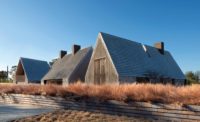H16 House
Werner Sobek's explorations in sustainability maintain the elegance of a Minimal design for the H16 House near Stuttgart.

A glass volume for living and dining spaces perches serenely atop a black-concrete-paneled base.The two are linked to a third volume, a garage, by a roof deck and are backed by a limestone retaining wall.
Photo © Zooey Braun

A glass volume for living and dining spaces perches serenely atop a black-concrete-paneled base.The two are linked to a third volume, a garage, by a roof deck and are backed by a limestone retaining wall.
Photo © Zooey Braun

Thin chords and triple glazing with silicon joints allow a panoramic view of the village from the kitchen, dining, and living spaces.
Photo © Zooey Braun

To foster the house’s lightweight quality, Sobek connected the lower-level terrace to the roof deck with an open-riser stair and cable balustrade. Bankirai wood clads the deck’s surfaces.
Photo © Zooey Braun

A stainless-steel stair with a fanfold pattern connects the private spaces to the upper-level living areas. A red composite-wood cabinet flanks the stair.
Photo © Zooey Braun

A stainless-steel stair with a fan-fold pattern connects the private spaces to the upper level living areas. A red composite-wood cabinet flanks the stair.
Photo © Zooey Braun

Photo © Zooey Braun

Photo © Zooey Braun

Image courtesy Werner Sobek Engineering and Design

Image courtesy Werner Sobek Engineering and Design










Record Houses 2008
Glenburn House ![]() H16
H16 ![]() Maltman Bungalows
Maltman Bungalows ![]() Palmyra House
Palmyra House ![]() The Rolling Huts
The Rolling Huts ![]() Wall House
Wall House ![]() Dairy House
Dairy House ![]() Nora House
Nora House ![]() VH r-10 gHouse
VH r-10 gHouse
It’s hardly a secret that Germany has long been at the forefront of energy-saving design. Even back in the early Modern days, its health-oriented obsession with getting natural light and cross ventilation into living quarters paved the way for later passive-energy-saving strategies. In the 1920s, “zeilenbau” planning principles, calling for long, narrow housing blocks to be placed in parallel rows on a north-south axis, allowed sun and air to easily penetrate interior spaces. Although the idea itself was not new, the urban scale of its application offered a model for future problem solving.
Today, German architects and engineers are advancing strategies for sustainable design that go far beyond the zeilenbau thinking, as demonstrated by the efforts of Werner Sobek. A structural engineer famous for such adventurous mega-schemes as Sony Plaza in Berlin (2000) and the Suvarnabhumi International Airport in Bangkok [RECORD, August 2007, page 108]—both designed by Murphy/Jahn—Sobek also runs the Institute for Lightweight Structures and Conceptual Design in Stuttgart.
Since Sobek was trained as an architect as well as an engineer, he also likes to design buildings on his own. In 2000, he built a house for himself, named R128, in Stuttgart, that explored a number of sustainable strategies. In 2006, Sobek completed his latest house, H16, for a young family in the village of Tieringen, not far from Stuttgart. The house, which he maintains is fully recyclable with zero emissions and zero energy use, sits atop a knoll, on a 17,028-square-foot site overlooking the picturesque village. The owner, Helmut Link, whose family business, Interstuhl Büromöbel, a furniture manufacturer, is located in Tieringen, wanted a Modern, flat-roofed house, with a full south-facing view—and no curtains. The town authorities favor the more gemütlich gabled-and-stuccoed residential architecture. But Link, his wife, Georgia, and Sobek persevered. It got approved.
From the slope to the south of the house, one immediately apprehends its straightforward parti. A glass-and-steel volume, approximately 23 feet deep and 56 feet long, devoted to the living, dining, and kitchen areas, rests on a deeper, steel-framed base, containing bedrooms, roomy baths, and an office. Enclosed by charcoal-black, non-load-bearing, precast-concrete panels, this volume is about 31 feet deep and 54 feet long. Operable, double-paned, narrow windows, between 16 inches and 3 feet in width and a little over 8 feet high, bring light and air into these lower-level quarters. A third, beige-precast-concrete volume, linked by a terrace and roof deck, contains the garage and service equipment for the 4,200-square-foot residence.
PeopleArchitect
Werner Sobek
Sven von Boetticher Interior designer: Werner Sobek Engineer(s): Werner Sobek Consultant(s): Landscape: Werner Sobek Lighting: Werner Sobek Environmental Consultant: TRANSPLAN Technik-Bauplanung GmbH Building Automation: Baumgartner GmbH Photographer(s):
zooey braun fotografie
|
ProductsExterior cladding Metal/glass curtainwall: Basler Metallbau GmbH & Co.Kg Concrete: R. Bayer Beton und Terrazzogruppe Steelwork, Facades, Roof: Basler Metallbau GmbH & Co.Kg |














